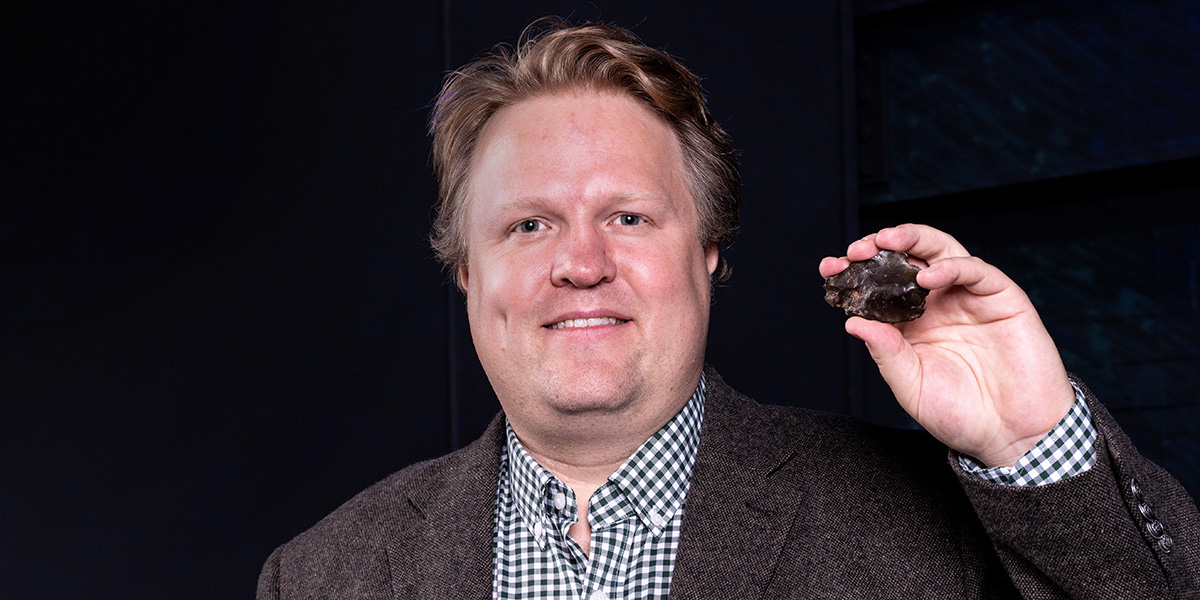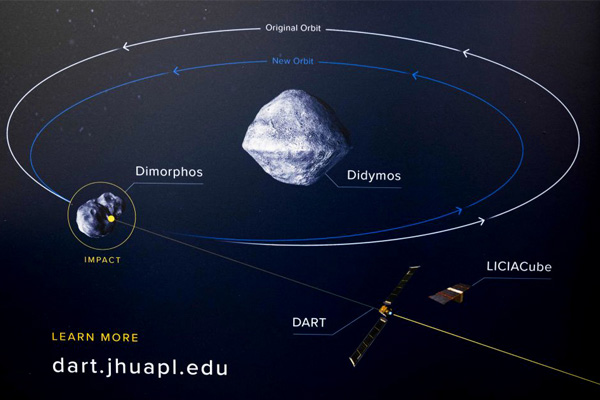How to stop an asteroid
MSU planetary scientists help advise NASA's planetary defense efforts
By Bethany Mauger

A n asteroid wiped out the dinosaurs 66 million years ago. It could happen again. No object that size has threatened Earth since — but scientists aren't letting their guard down. While NASA leads the search for potentially dangerous space rocks, Michigan State University researchers support the effort with critical insights on how asteroids behave, and how they might be deflected.
As contributors to NASA's Planetary Defense Coordination Office, College of Natural Science planetary scientists help shape strategies for protecting Earth from future impacts.
It's a chance for Seth Jacobson, Assistant Professor in the Department of Earth and Environmental Sciences, to take his research from theory to real-world application.
Jacobson was part of a scientific working group on NASA's Double Asteroid Redirection Test, or DART, team. In recent years, the group worked with NASA to launch a spacecraft and test their theory that the ship could nudge an asteroid off course.
"Being involved in planetary defense is a really great marriage of science and practicality," Jacobson said.
What are asteroids?
Billions of years ago, the planets that form our solar system slowly grew from a disk of gas and dust. Planetary scientists call this period the era of accretion. The scraps left over from this process are many of the asteroids and comets we know today.
Jacobson is interested in asteroids because they're more than space rocks. They offer clues to how planets were formed and where we came from.
"We can turn to meteorites that come from asteroids and comets to understand what the building blocks of Earth were like," Jacobson said. "It's like looking at the rubble at a construction site to understand what the building is made of."
What we call a near-Earth asteroid is essentially a giant pile of gravel. Over the past four and a half billion years, objects in the Asteroid Belt have crashed into one another and broken down into small bits. Those bits reaccumulate and are held together by gravity.
Surveying the sky

To protect Earth from potentially hazardous asteroids, scientists first must systematically detect threatening objects, Astrophysics Assistant Professor Darryl Seligman said. NASA tasked its planetary defense office with finding and tracking all near-Earth objects larger than 130 meters.
To do this, researchers conduct a whole sky survey. Every night, they use a network of observatories, including the The Panoramic Survey Telescope and Rapid Response S in Hawaii and the new Vera C. Rubin Observatory in Chile, to capture images of the entire sky. Then, they compare those images each night to find moving objects.
Any newly discovered moving object is reported to the Minor Planet Center, which runs an algorithm to determine what the object is. The orbit is continually updated and refined as new data is reported. The trajectory is used to map out where the object will be in the future, and whether there's any danger of it hitting Earth.
Seligman springs into action when an object is spotted that can't be explained by the rules for normal asteroids and comets. He led the discovery of dark comets in 2023 — comets with a non-gravitational acceleration and no tail — and later found seven more that showed two distinct populations of dark comets. He also wrote the first scientific paper on an interstellar object spotted in July.
Most objects, however, follow a predictable trajectory. This allows astrophysicists to calculate where they'll be 50 to 100 years into the future.
"Everything is continually updated as new data comes in, and you get better and better measurements of the orbits of everything in the solar system," Seligman said. "Once you understand the orbit, the degree of uncertainty gets smaller."
Deflecting an asteroid

The point of studying the sky every night is to spot a potentially damaging asteroid with enough time to do something about it.
In movies like "Armageddon," "Deep Impact" and the recent "Don't Look Up," scientists have only a short window of time to thwart the asteroid and save the planet. Jacobson said that's unrealistic. Asteroids large enough to put one area at risk, much less the entire planet, require multiple years' notice. The larger the asteroid, the more time NASA needs to intervene.
No known asteroid is currently on a collision course with Earth, though scientists at one time thought near-Earth asteroid Apophis was hurtling toward impact. If, and when, an asteroid poses a direct threat, NASA has a plan.
NASA relies on a method called kinetic deflection, meaning a spaceship intentionally crashes into the object. In the theory, the collision bumps the object off of its projected orbit just enough to fly harmlessly by our planet.
"You can imagine that it would be like two billiard balls banking off of one another in the kind of physics we've known and understood for a long time," Jacobson said. "The problem is, an asteroid is anything but a billiard ball."
Because an asteroid is essentially a rubble pile, it falls apart upon impact, throwing off rocks and losing momentum. Computer simulations of this impact varied drastically, depending on the assumptions made.
That's what led to DART. Jacobson's expertise on small bodies eventually brought him in an advisory role to the DART mission.
NASA launched the spacecraft in November 2021 headed toward a pair of asteroids, Didymos, and its small moon, Dimorphos. Nearly a year later, the spacecraft smacked into Dimorphos full tilt at 14,000 miles per hour.
NASA hit the asteroid's moon because researchers had already measured its orbit. If DART shifted it at all, scientists could measure the change.
"You can imagine that it would be like two billiard balls banking off of one another in the kind of physics we've known and understood for a long time ... the problem is, an asteroid is anything but a billiard ball." Seth Jacobson
Assistant Professor, Earth and Environmental Sciences
Within seven months, Dimorphos's orbit shortened by 32 minutes. In the future, scientists can use this information to fine-tune future missions to thwart an asteroid.
A growing astronomy presence
Planetary defense is like an insurance policy scientists hope we'll never need, Jacobson said. As NASA keeps its eyes on the sky, MSU researchers continue provide their expertise. This work will only continue to grow as more planetary and exoplanetary scientists join the Physics and Astronomy and the Earth and Environmental Science departments. What started as a group of just two has grown to more than a dozen.
If an asteroid ever poses a threat, College of Natural Science researchers are ready to offer their expertise.
"Near-Earth objects are a unique threat," Jacobson said. "But they're also something that we can totally do something about."
